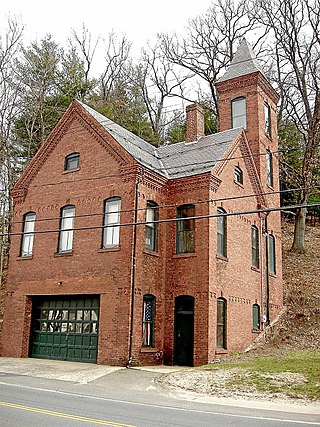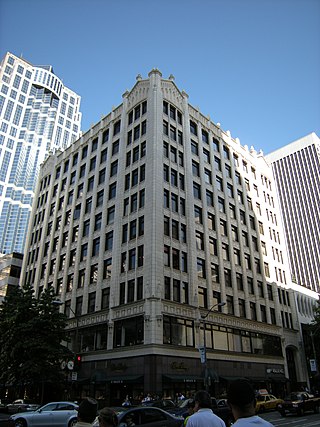
Pioneer Square is a neighborhood in the southwest corner of Downtown Seattle, Washington, US. It was once the heart of the city: Seattle's founders settled there in 1852, following a brief six-month settlement at Alki Point on the far side of Elliott Bay. The early structures in the neighborhood were mostly wooden, and nearly all burned in the Great Seattle Fire of 1889. By the end of 1890, dozens of brick and stone buildings had been erected in their stead; to this day, the architectural character of the neighborhood derives from these late 19th century buildings, mostly examples of Richardsonian Romanesque.

Cherry Hill is a predominantly residential area in Seattle, Washington located south of Capitol Hill within the Central District, north of the International District, and east of First Hill. Cherry Hill is bound on the west by 14th Avenue, on the east by 23rd Avenue, on the north by East Madison Street and on the south by East Yesler Way. Cherry Hill overlaps considerably with the neighborhood of Squire Park as defined by the Squire Park Neighborhood Council. In the Seattle City Clerk's Geographic Indexing Atlas, Cherry Hill is designated as the Minor neighborhood of the Central Area. Cherry Hill was previously called Second Hill or Renton Hill.

Quincy Point Fire Station is a historic fire station at 615 Washington Street in Quincy, Massachusetts. Built in 1941, it is the third firehouse to occupy the location, and is one of the city's finest examples of Colonial Revival architecture. It was listed on the National Register of Historic Places in 1994.

The Niagara Engine House is located on North Hamilton Street in downtown Poughkeepsie, New York, United States. It is a brick building constructed in the early 20th century, the only extant fire house of the six engine companies that once protected the city.

Frederick Heath was an American architect responsible for numerous projects in Tacoma, Washington. He worked out of his own office and as a senior partner at architectural firms. He was involved with Spaulding, Russell & Heath, and Heath & Gove. His work included designs for several historic and notable schools, churches, stadiums, and commercial properties.

The West End Hose Company Number 3 is a historic two-story brick firehouse located at 15 North Doughty Avenue in the borough of Somerville in Somerset County, New Jersey, United States. The building was added to the National Register of Historic Places on July 17, 2002 for its significance in architecture and social history. The building is currently the Somerville Fire Department Museum operated by the Somerville Exempt Firemen's Association.

The Tunxis Hose Firehouse is an historic firehouse at Lovely Street and Farmington Avenue in the center of Unionville, Connecticut. BUilt in 1893, it is a well-preserved example of a late 19th-century rural firehouse with Queen Anne Victorian features. The building was listed on the National Register of Historic Places on July 28, 1983. It presently houses a muster vehicle for Tunxis Hose Company No. 1, a local volunteer fire company.

The Central Fire Station is located in downtown Davenport, Iowa, United States and serves as the headquarters of the Davenport Fire Department, as well as the downtown fire station. Built from 1901 to 1902, the original building is the oldest active fire station west of the Mississippi River. It was individually listed on the National Register of Historic Places in 1982. In 2020 it was included as a contributing property in the Davenport Downtown Commercial Historic District.

Davenport Hose Station No. 3 is located in a commercial area on the east side of Davenport, Iowa, United States. It has been listed on the National Register of Historic Places since 1984. The building is one of two historic former fire stations on the east side that are still in existence. The other one is Hose Station No. 4 in the Village of East Davenport.

The National Building is a historic warehouse building in downtown Seattle, Washington, located on the east side of Western Avenue between Spring and Madison Streets in what was historically Seattle's commission district. It is now home to the Seattle Weekly. It is a six-story plus basement brick building that covers the entire half-block. The dark red brick facade is simply decorated with piers capped with small Ionic capitals and a small cornice, which is a reproduction of the original cornice. Kingsley & Anderson of Seattle were the architects.

Portland Fire Station No. 23 in southeast Portland in the U.S. state of Oregon is a two-story structure listed on the National Register of Historic Places. Built in Italianate style in 1913, it was added to the register in 1989.
Francis W. Wilson was an American architect. His practice in Santa Barbara, California included work for the Atchison, Topeka and Santa Fe Railway and its associated Fred Harvey Company hotels, as well as many residences.

Portland Fire Station No. 7, located in southeast Portland in the U.S. state of Oregon, is a two-story structure listed on the National Register of Historic Places. Built in 1927, it was added to the register in 1989. It was the last of numerous Portland firehouses to be designed by fire chief and architect Lee Gray Holden, who died of a stroke while visiting the No. 7 firehouse in 1943. The building continued to be used by the city's Fire Department until the 1980s, when it was sold off and used as an automobile garage. It was acquired by a local developer in 2009, and was restored and remodeled for office and retail use.

Fire Station No. 18 was a fire station located in the Ballard neighborhood of Seattle, Washington listed on the National Register of Historic Places. It is now used as a nightclub and music venue.

The architecture of Seattle, Washington, the largest city in the Pacific Northwest region of the U.S., features elements that predate the arrival of the area's first settlers of European ancestry in the mid-19th century, and has reflected and influenced numerous architectural styles over time. As of the early 21st century, a major construction boom continues to redefine the city's downtown area as well as neighborhoods such as Capitol Hill, Ballard and, perhaps most dramatically, South Lake Union.

Julian Franklin Everett was an American architect known for the buildings he designed in Seattle, Washington. His work includes a synagogue for the Temple de Hirsch congregation (1908) and the Pioneer Square Comfort Station and Pergola in Seattle (1909), now a historic landmark. Some of his works, including the temple and a building for Pathé Exchange, were later demolished, while others are listed on the National Register of Historic Places (NRHP).

Engine Company 29, at 4811 MacArthur Blvd. NW in Washington, D.C., is a fire station built in 1925. It was listed on the National Register of Historic Places in 2007.

The Liggett Building, also referred to as the Fourth & Pike Building, is a historic 10-story office building at 1424 4th Avenue in downtown Seattle, Washington. It was built in 1927 by the Louis K. Liggett Company, leasing the property from the estate of local pioneer George Kinnear, to house the first Seattle location of their national drug store chain. Liggett's would break their 99-year lease on the building only a few years later after having opened a second location only a block away proved financially unwise during the Great Depression. The building received its current name after a 1933 renovation. Designed by Lawton & Moldenhour in the Gothic revival style, it is clad entirely in locally manufactured terracotta. It is an official Seattle City Landmark and was listed on the National Register of Historic Places on August 31, 2011.

The Beezer Brothers were American architects active from the late 19th-century to the Great Depression. They were twins, who practiced together in western Pennsylvania before moving to Seattle, Washington in 1907 to participate in the city's rapid growth brought on by the Klondike Gold Rush. Best known for the many Catholic churches they designed, they also worked on domestic residences and municipal buildings. Their work on the west coast, while concentrated in Seattle, can be found from Los Angeles to San Francisco to Alaska, and inland to Montana. At least one church and two buildings are individually listed on the National Register of Historic Places, and several other buildings are contributing properties to several different National Historic Districts.




















